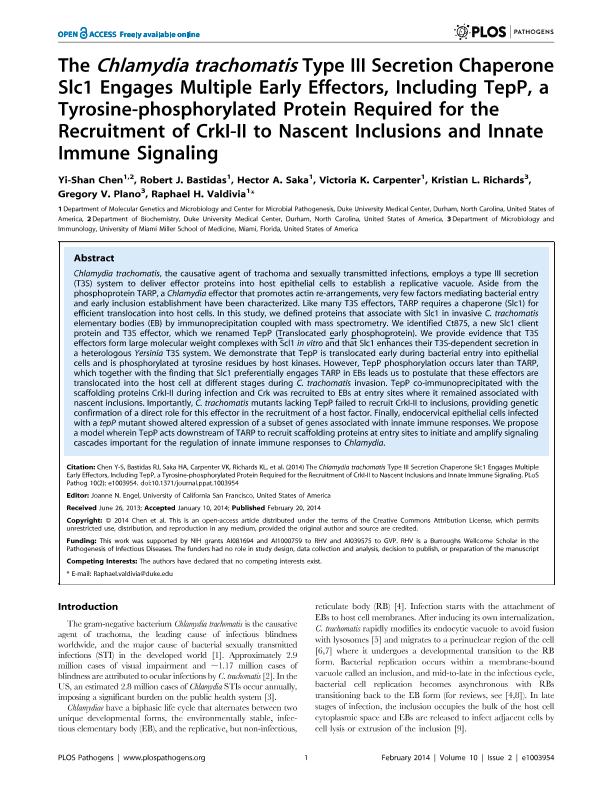Mostrar el registro sencillo del ítem
dc.contributor.author
Chen, Yi-Shan
dc.contributor.author
Bastidas, Robert J.
dc.contributor.author
Saka, Hector Alex

dc.contributor.author
Carpenter, Victoria K.
dc.contributor.author
Richards, Kristian L.
dc.contributor.author
Plano, Gregory V.
dc.contributor.author
Valdivia, Raphael H.
dc.date.available
2020-03-17T17:37:19Z
dc.date.issued
2014-03
dc.identifier.citation
Chen, Yi-Shan; Bastidas, Robert J.; Saka, Hector Alex; Carpenter, Victoria K.; Richards, Kristian L.; et al.; The Chlamydia trachomatis Type III Secretion Chaperone Slc1 Engages Multiple Early Effectors, Including TepP, a Tyrosine-phosphorylated Protein Required for the Recruitment of CrkI-II to Nascent Inclusions and Innate Immune Signaling; Public Library of Science; Plos Pathogens; 10; 2; 3-2014; 1-17
dc.identifier.issn
1553-7366
dc.identifier.uri
http://hdl.handle.net/11336/99858
dc.description.abstract
Chlamydia trachomatis, the causative agent of trachoma and sexually transmitted infections, employs a type III secretion (T3S) system to deliver effector proteins into host epithelial cells to establish a replicative vacuole. Aside from the phosphoprotein TARP, a Chlamydia effector that promotes actin re-arrangements, very few factors mediating bacterial entry and early inclusion establishment have been characterized. Like many T3S effectors, TARP requires a chaperone (Slc1) for efficient translocation into host cells. In this study, we defined proteins that associate with Slc1 in invasive C. trachomatis elementary bodies (EB) by immunoprecipitation coupled with mass spectrometry. We identified Ct875, a new Slc1 client protein and T3S effector, which we renamed TepP (Translocated early phosphoprotein). We provide evidence that T3S effectors form large molecular weight complexes with Scl1 in vitro and that Slc1 enhances their T3S-dependent secretion in a heterologous Yersinia T3S system. We demonstrate that TepP is translocated early during bacterial entry into epithelial cells and is phosphorylated at tyrosine residues by host kinases. However, TepP phosphorylation occurs later than TARP, which together with the finding that Slc1 preferentially engages TARP in EBs leads us to postulate that these effectors are translocated into the host cell at different stages during C.trachomatis invasion. TepP co-immunoprecipitated with the scaffolding proteins CrkI-II during infection and Crk was recruited to EBs at entry sites where it remained associated with nascent inclusions. Importantly, C. trachomatis mutants lacking TepP failed to recruit CrkI-II to inclusions, providing genetic confirmation of a direct role for this effector in the recruitment of a host factor. Finally, endocervical epithelial cells infected with a tepP mutant showed altered expression of a subset of genes associated with innate immune responses. We propose a model wherein TepP acts downstream of TARP to recruit scaffolding proteins at entry sites to initiate and amplify signaling cascades important for the regulation of innate immune responses to Chlamydia.
dc.format
application/pdf
dc.language.iso
eng
dc.publisher
Public Library of Science

dc.rights
info:eu-repo/semantics/openAccess
dc.rights.uri
https://creativecommons.org/licenses/by-nc-sa/2.5/ar/
dc.subject
CHLAMYDIA
dc.subject
TYPE THREE SECRETION
dc.subject
VIRULENCE
dc.subject
PROTEOMICS
dc.subject.classification
Biología Celular, Microbiología

dc.subject.classification
Ciencias Biológicas

dc.subject.classification
CIENCIAS NATURALES Y EXACTAS

dc.title
The Chlamydia trachomatis Type III Secretion Chaperone Slc1 Engages Multiple Early Effectors, Including TepP, a Tyrosine-phosphorylated Protein Required for the Recruitment of CrkI-II to Nascent Inclusions and Innate Immune Signaling
dc.type
info:eu-repo/semantics/article
dc.type
info:ar-repo/semantics/artículo
dc.type
info:eu-repo/semantics/publishedVersion
dc.date.updated
2020-03-12T18:58:28Z
dc.journal.volume
10
dc.journal.number
2
dc.journal.pagination
1-17
dc.journal.pais
Estados Unidos

dc.journal.ciudad
San Francisco
dc.description.fil
Fil: Chen, Yi-Shan. University of Duke; Estados Unidos
dc.description.fil
Fil: Bastidas, Robert J.. University of Duke; Estados Unidos
dc.description.fil
Fil: Saka, Hector Alex. Consejo Nacional de Investigaciones Científicas y Técnicas. Centro Científico Tecnológico Conicet - Córdoba; Argentina. University of Duke; Estados Unidos
dc.description.fil
Fil: Carpenter, Victoria K.. Duke University Medical Center; . University of Duke; Estados Unidos
dc.description.fil
Fil: Richards, Kristian L.. Miami University; Estados Unidos
dc.description.fil
Fil: Plano, Gregory V.. Miami University; Estados Unidos
dc.description.fil
Fil: Valdivia, Raphael H.. University of Duke; Estados Unidos
dc.journal.title
Plos Pathogens

dc.relation.alternativeid
info:eu-repo/semantics/altIdentifier/url/http://dx.plos.org/10.1371/journal.ppat.1003954
dc.relation.alternativeid
info:eu-repo/semantics/altIdentifier/url/https://www.ncbi.nlm.nih.gov/pmc/articles/PMC3930595/
dc.relation.alternativeid
info:eu-repo/semantics/altIdentifier/doi/http://dx.doi.org/10.1371/journal.ppat.1003954
Archivos asociados
